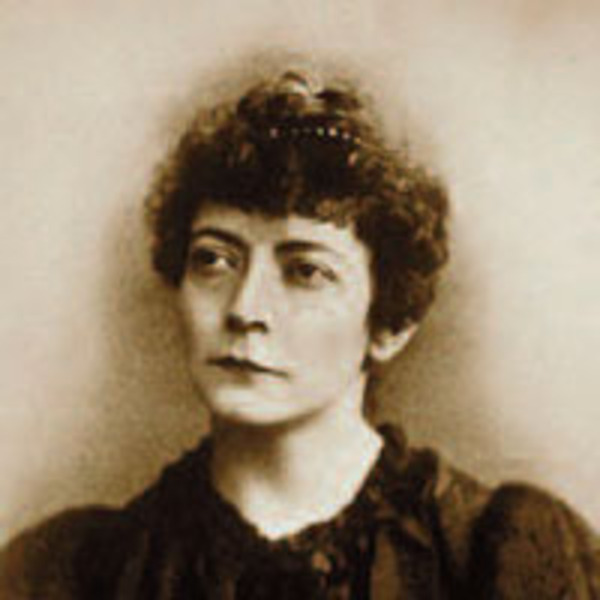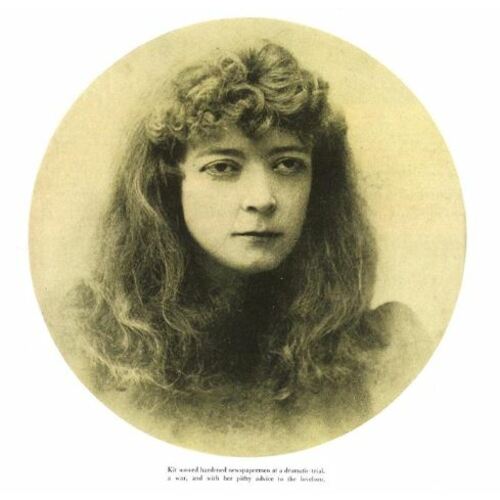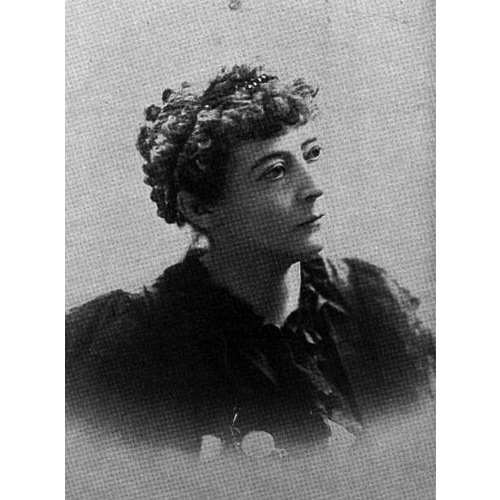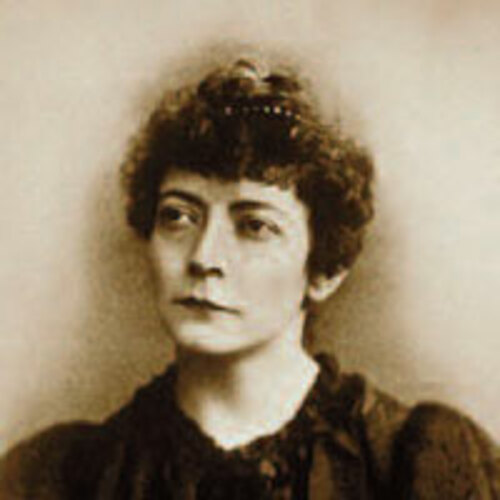
Source: Courtesy of Wikimedia Commons
FERGUSON, CATHERINE (Kathleen Blake) (Willis; Watkins; Coleman), known as Kit Coleman, journalist and war correspondent; b. 20 Feb. 1856 at Castleblakeney (Republic of Ireland), daughter of Mary Burke and Patrick Ferguson; m. first c. 1876 Thomas Willis, and they had one daughter; m. secondly c. 1884 Edward J. Watkins in Toronto, and they had one son and one daughter; m. thirdly 25 Aug. 1898 Theobald Coleman in Washington; there were no children in the third marriage; d. 16 May 1915 in Hamilton, Ont.
Catherine Ferguson grew up in the countryside around Galway, the daughter of a middle-class farmer. Her parents had little money but still managed to have her educated thoroughly in languages and the classics at Loretto Abbey in Rathfarnham and a finishing school in Belgium. As an adult, she credited her father for inspiring in her an enduring love of nature and of books, and her mother, who was blind, for teaching her to love music and to play several instruments. The strongest influence on her intellectual life, however, was her uncle Thomas Nicholas Burke, a Dominican priest and a renowned liberal and orator. He taught her religious and social tolerance, an attitude that was reflected in her journalism as an adult.
At 20 Kathleen, to use the name she had adopted, entered a marriage her family had arranged to Thomas Willis, a wealthy landowner many years her senior. The couple had one child, who died in early childhood. The marriage was an unhappy one, and when her husband also died, Kathleen was disinherited by his family. After going first to London Kathleen emigrated to Canada in 1884. Shortly after she arrived she married a charming and handsome Englishman, Edward J. Watkins, a Toronto salesman. For a short time they lived in Winnipeg, where Edward was a commercial salesman and Kathleen taught music and French. They were never well off; moreover, Edward turned out to be a philanderer and a drunkard, and he was probably a bigamist as well. Around the time the couple separated, Kathleen adopted Blake as her middle name, claiming to be a member of that prominent Galway family, and was hired by Edward Farrer in 1889 as women’s editor of the Toronto Daily Mail, work she needed to help support herself and her two young children. It is likely that she hired a housekeeper to care for her children, an affordable option for most middle-class families at the time; later she placed them in boarding-schools. She also wrote short stories to augment her income, first publishing in Edmund Ernest Sheppard*’s Saturday Night in 1889 and 1890.
Kathleen’s weekly column, which eventually became the “Woman’s Kingdom” page, appeared for the first time in the Mail in October 1889. Writing as Kit, she became an accomplished and popular journalist, known for her vivid prose, quick intelligence, and irreverent wit. The women’s pages, a recent innovation in North American newspapers, were designed to attract both female readers and advertisers of household and beauty products. But she rebelled against her editors’ assumptions that women were interested only in housekeeping, fashion, and her advice column, and insisted on writing about other things she felt would interest them – politics, business, religion, and science. Even so, Kathleen, who was restless by nature, found her “Woman’s Kingdom,” and Toronto, limiting. Whenever she could, beginning in 1892, she travelled, sending her editors and readers colourful accounts of her journeys to Ireland and England, across North America, and to the West Indies. When the Mail merged with the Empire in 1895 she continued as the women’s page editor of the new paper. By this time, Kit had earned an enviable international reputation. An American reference work in 1894 called her work “brilliant” and noted that no woman journalist, and possibly no male below the rank of editor-in-chief, had a more direct influence on the prestige and circulation of any North American newspaper.
The high point of Kathleen’s career occurred during the Spanish-American War when she became the first woman to be accredited as a war correspondent by the United States government. Having volunteered for an assignment to Cuba, which the Daily Mail and Empire clearly treated as a stunt to draw readers, she was told to write features and “guff,” as she called it, not the news from the front, which was the province of the male correspondents. Although she was authorized to accompany American troops, other correspondents and the military authorities were angered by the decision and almost succeeded in keeping her stranded in Florida. She persevered and arrived in Cuba in July 1898 just before the war ended. Her dramatic and heart-rending accounts of the aftermath of the war and of its human casualties made her famous.
On her way back to Canada, Kathleen stopped in Washington where she addressed the International Press Union of Women Journalists and married for the third time. Her husband was Theobald Coleman, a kindly Canadian doctor who appeared to respect her desire to continue her career; she would write a few years later that it was unwise for any woman to rely on a man for her economic security, for such “dependence is the foundation of most of the tragedy of woman’s lot.” After their marriage the Colemans moved first to Copper Cliff (Sudbury), Ont., where Theobald was employed by the Canadian Copper Company, and then in 1904 to Hamilton. Kathleen continued to produce a column for the Mail and Empire until 1911, when she resigned from the newspaper following its decision to eliminate her popular correspondence column from the “Kingdom” and have her write a short, daily column as well as her weekly page. She then produced a syndicated column which various newspapers picked up.
Given her history, Kathleen had every reason to support the women’s issues of her day, particularly economic and political equality. Most of her sister journalists, including her Mail and Empire colleague Katherine Hale [Amelia Beers Warnock*], looked up to Kit as a pioneer and a role model, and the suffragists among them hoped that she would become an activist in their cause. Because she had worked as a single mother for much of her career, Kathleen strongly believed, as they did, in equal pay for equal work. In 1904, angered by the discrimination suffered by women in her profession, she helped establish the Canadian Women’s Press Club, and she served as its first president.
She did not come out publicly in favour of women’s suffrage until 1910, however, partly because the Mail and Mail and Empire adamantly opposed it. She also felt unsure about the extent to which women – and “objective” journalists – should become involved in politics. Her feelings of uncertainty were not just a matter of temperament or of professional considerations: many accomplished women of her day were torn between the new opportunities for their sex, and the more self-effacing expectations of womanhood that they learned as girls.
Kathleen Blake Coleman spent most of her 25 years as a journalist walking a creative tightrope between what was considered acceptable behaviour for a woman journalist and what was considered too daring. Her realistic but chronic fear of poverty, the demands of her editors, and her own Victorian upbringing may have combined to rob her, at times, of the courage of her convictions, especially where the rights of women were concerned. But in her own day she was considered a romantic, adventurous, talented, and accomplished woman, who expanded the narrow boundaries of the woman journalist’s world, and that of her readers as well.
In addition to her newspaper columns, Kit Coleman’s publications include To London for the jubilee (Toronto, 1897). One of her short stories, “A pair of gray gloves,” Canadian Magazine, 22 (November 1903–April 1904): 121–25, appears in the anthology New women: short stories by Canadian women, 1900–1920, ed. Sandra Campbell and Lorraine McMullen (Ottawa and Paris, 1991), 46–55.
NA, MG 28, I 232; MG 29, D112. Hamilton Herald (Hamilton, Ont.), 1911–14. Toronto Daily Mail, 1889–95, continued as the Daily Mail and Empire, 1895–1911. Canada Monthly (London, Ont.), 1911–15. Carol Dyhouse, Girls growing up in late Victorian and Edwardian England (London, 1981). W. J. Fitzpatrick, The life of the Very Rev. Thomas N. Burke (London, 1885). B. M. Freeman, Kit’s kingdom: the journalism of Kathleen Blake Coleman (Ottawa, 1989). Deborah Gorham, The Victorian girl and the feminine ideal ([Bloomington, Ind.], 1982). Michael Schudson, Discovering the news: a social history of American newspapers (New York, 1978). Carroll Smith-Rosenberg, Disorderly conduct: visions of gender in Victorian America (New York, 1985).
Cite This Article
Barbara M. Freeman, “FERGUSON, CATHERINE (Kathleen Blake) (Willis; Watkins; Coleman), known as Kit Coleman,” in Dictionary of Canadian Biography, vol. 14, University of Toronto/Université Laval, 2003–, accessed December 31, 2025, https://www.biographi.ca/en/bio/ferguson_catherine_14E.html.
The citation above shows the format for footnotes and endnotes according to the Chicago manual of style (16th edition). Information to be used in other citation formats:
| Permalink: | https://www.biographi.ca/en/bio/ferguson_catherine_14E.html |
| Author of Article: | Barbara M. Freeman |
| Title of Article: | FERGUSON, CATHERINE (Kathleen Blake) (Willis; Watkins; Coleman), known as Kit Coleman |
| Publication Name: | Dictionary of Canadian Biography, vol. 14 |
| Publisher: | University of Toronto/Université Laval |
| Year of publication: | 1998 |
| Year of revision: | 1998 |
| Access Date: | December 31, 2025 |





